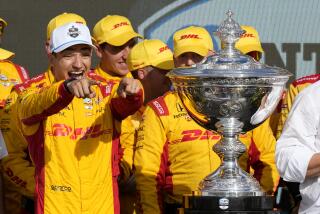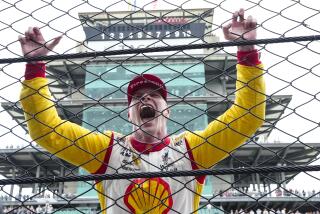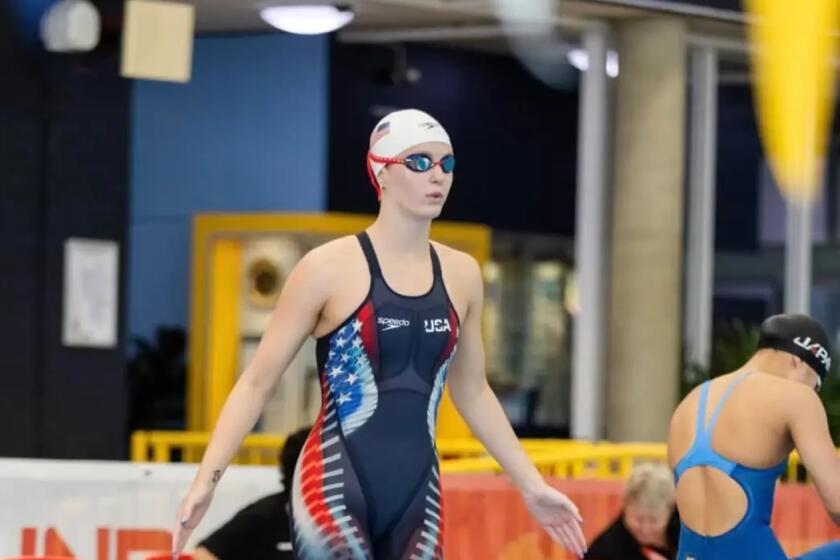Speed the Name of Game at This Indy 500
- Share via
INDIANAPOLIS — At about 240 m.p.h., the car is a green and white blur as it crosses the yard of bricks that marks the start-finish line on the long front straightaway.
The electronic clock stops at 38.690 seconds, and the average speed for the lap around the 2 1/2-mile Indianapolis Motor Speedway oval takes an instant to blink onto the computer screen--232.618 m.p.h.
By the time the brain registers the number and begins to digest its immensity, Indianapolis 500 pole-winner Roberto Guerrero’s Lola-Buick is alreading racing out of the first turn and setting up for Turn 2 on yet another incredible lap.
Awesome!
How can these human beings who choose to drive the open-wheel rockets known as Indy cars do it? The speeds keeping going up, but the track, built in 1909, hasn’t changed appreciably since asphalt replaced bricks in 1937.
It’s still a roadway just 50-to-60-feet wide with two long straightaways and two turns at each end separated by short straightaways known as chutes.
The machines make it possible for drivers to go that fast, but it’s the drivers themselves who must hold the throttle to the floor as the ‘G’ forces press down on them and the concrete walls lurk just feet away.
It’s reached the point where spectators hardly react until the public address system squawks out laps of 230 or more.
“Who would have ever thought you’d come to the speedway and go 225 . . . and the fans are up there yawning?” asked John Andretti, racing at Indy for the fifth time.
The 33-car field for today’s Indianapolis 500 has a record average of 223.479 m.p.h., led by Guerrero’s four-lap qualifying run of 232.482. The slowest qualifier in the field, rookie Ted Prappas at 219.173, is faster than the field average of 218.590 the previous year.
Few of the drivers enjoy the speeds they have to run to make the lineup. But they have no choice if they want to be part of the world’s most important auto race.
“People keep talking about the engines and horsepower,” says Jim Crawford, who several years ago had a terrible, bone-breaking crash when he tried to drive through Turn 1 at more than 230 mph on a qualifying attempt. “But horsepower isn’t what gets you to the middle of Turn 1 at 230 m.p.h.”
The fine line the drivers tread was tragically demonstrated on May 15 when 27-year-old Jovy Marcelo of the Philippines, an Indy rookie, became the speedway’s first driver fatality in 10 years. He died of massive head injuries after hitting the wall at about 200 m.p.h.
There have been much worse crashes, at far higher speeds. But the consequences of this one raised the same old question: Why do they need to go so fast?
“I’m not sure we need to be going this fast, but speed is pretty relative,” said 1969 Indy winner Mario Andretti, who was a rookie in 1965 when top qualifying speeds flirted with 160.
“You can’t be afraid of it and be here,” said Andretti, 52, who will start today’s race from the outside of the front row. “The cars are as safe as they’ve ever been, but there will never be a safe race car.
“Speed so far hasn’t been a problem,” Andretti continued. “When the cars were slower, they were more unstable and we had a lot more crashes. The guys out there ran out of paint from having to keep repainting the walls.
“In a lot of ways, the speed is the least of your problems, particularly in the race. The big problem comes if something breaks and you just become a passenger or if something else goes wrong and you have virtually no time to react. The walls are right there. That’s the only thing you fear.”
Eddie Cheever, starting from the middle of the front row, said success in Indy cars depends on the ability to anticipate potential problems.
“If you have to react, it’s over, finished,” Cheever said.
Dale Coyne, former driver and member of the rules committee for IndyCar, the series sanctioning body, owns the cars qualified by rookies Eric Bachelart of Belgium and Brian Bonner.
“Jovy’s accident was very unfortunate because it wasn’t as bad of an accident as some of the other ones we’ve had this month,” Coyne said. “We can never stop looking at safety.
“We’ve always got to make these (cars) safer and that’s what the rules committees are all about. You walk a fine line because you’ve got to make the cars safer without outdating the cars, so it’s tricky.”
Once the race begins, speeds generally become slower and somewhat secondary, with drivers concerned more with traffic, air turbulence and pit strategy. The one-lap speed record in the race is 222.574 m.p.h., set in 1990 by Emerson Fittipaldi on lap 91 and equalled by Arie Luyendyk on lap 162 in the same race.
“I expect we’ll see those speeds go up, too,” Luyendyk, the 1990 winner, said. “We’ll probably have some laps in the 224-225 range in the race once the field gets stretched out everybody makes some adjustments.”
Cheever, making his third Indy start, said, “I believe traffic can be a problem because we could easily be doing 225-226 in the race . . . that’s faster than last year’s pole.”
But, no matter what speeds are made possible by technology and aerodynamics, it all comes back to the person behind the wheel.
More to Read
Go beyond the scoreboard
Get the latest on L.A.'s teams in the daily Sports Report newsletter.
You may occasionally receive promotional content from the Los Angeles Times.










